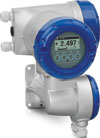

When the measuring tube of a mechanical flowmeter is empty, its flow indicator indicates the value 0 and flow totalising stops. This is not the case with an EMF device, where the electrodes are no longer in contact with the process liquid and are open.
The electrode circuit has high impedance when the tube is empty making it susceptible to electrical interference and coupling from the surroundings which can lead to error flow readings and totalised values.
Empty pipe detection via the electrode resistance
When the measuring tube is completely filled, the measuring electrodes are connected to each other and against the reference point of the EMF via the process liquid. The resistance between the measuring electrodes or from one electrode to a reference point is a factor of the conductivity of the process liquid. This resistance is lower with a completely filled measuring tube than with an empty measuring tube.
The advantage of this method is that no additional hardware expense is necessary for the primary head. The disadvantage, however, is that the switching process only takes place when the liquid level drops below the electrode axis. Therefore, should the measuring tube become coated due to build-up, this method no longer functions reliably. It also becomes problematic with vertical and long pipelines in which the process liquid runs down the tube walls for an extended period of time.
Full pipe detection via a full pipe electrode
An additional electrode is attached in the top of the measuring tube. When the EMF is installed in a horizontal pipeline, this electrode indicates partial filling even if the process liquid level decreases only slightly. Here too, the switching point must be set below the lowest electrical conductivity that can occur in the process.
The advantage of an additional full pipe electrode is the early indication of a partially filled measuring tube. When filling or emptying the pipeline, large volumes of the process liquid are not measured and totalised before the pipeline has been fully filled or emptied again. In addition, the full pipe electrode does not respond at all, or only very slowly, in the case of highly viscous process liquids, incrustations and coating sludge. The full pipe electrode indicates ‘pipe not full’ even if only minimal gas content has collected at the top of the tube.
Full pipe detection via the flow profile test
When a pipeline is partially filled the flow profile is asymmetrical. There is less process liquid flowing in the upper part of the measuring tube than in the lower part.
The Krohne IFC 300 signal converter can monitor the measuring tube for complete filling using its diagnostic function ‘flow profile test’, regardless of electrical conductivity, viscosity and incrustations. Generally, the flow profile test only responds when the liquid level has sunk below a value of about 75%. The empty pipe detector must then be activated as well.
Empty pipe shutoff via external control signals
This is the simplest and most reliable method of empty pipe shutoff. It uses information and control signals for pumps and valves which exist in most plants. Almost all EMF signal converters feature binary control inputs. This allows the outputs to be set to 0 and the counter to be stopped. Only the control signals of the pumps or valves must be applied to the control input of the signal converter.
This method is simple and reasonable. In addition, the empty pipe shutoff is guaranteed regardless of the process liquid properties such as conductivity, viscosity and contamination in the measuring tube. However, there is the risk that any volume that comes after the pumps have been switched off, or while the valve was closed, may not be measured. In addition, the empty pipe detection must be slightly delayed in relation to the starting of the pump and opening of the valve so that the pipeline is sufficiently filled before measurement can start again.
The signal converter can be combined with any measuring sensor. In terms of available housing versions, there is a compact variant, in which the signal converter is connected to the measuring sensor, as well as the field, wall and 19” rack-mounted designs.
For more information contact John Alexander, Krohne SA, +27 (0)11 314 1391, johna@krohnesa.co.za, www.krohne.com
| Tel: | +27 11 314 1391 |
| Email: | salesza@krohne.com |
| www: | www.za.krohne.com |
| Articles: | More information and articles about KROHNE |

© Technews Publishing (Pty) Ltd | All Rights Reserved